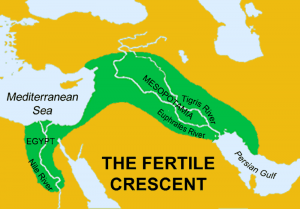So-called “conventional” agriculture is literally destroying the basis of human life – which is the soil beneath our feet. I believe this constitutes the greatest single threat to the survival of today’s civilisations, and addressing it should be humanity’s #1 concern.
Look at the two photos I took today of a field near me. It is the 23rd of April, springtime in England, and everywhere life is literally bursting out… everywhere, that is, except for fields like this.


There are practically zero visible signs of life in this field! And this is the norm. This is what we call “conventional”. This is what we’re told will continue to feed 8+-billion people. It will not!
The scale of the problem
An estimated 99.7% of the calories we eat derives from the soil, with the remaining 0.3% coming from the sea. Clearly, if we had no soil, that would mean the end for most of the human race. Unfortunately, we are facing that exact fate with a few generations.
Most estimates indicate that most farmed areas of the world have about 60 years left before the soil is gone. This map shows the extent of degradation around the world. Red areas are one step away from becoming desert.
The end of civilisation
Don’t believe me that our agricultural methods will destroy us? The evidence is unequivocal: it has already happened to every single civilisation built on annual agriculture!
If we look back through history, every advanced civilisation before us has collapsed, and some academics believe they collapsed for the same reason: because they destroyed the topsoil that provided their food.
“Great civilisations have fallen because they failed to prevent the degradation of the soils on which they were founded. The modern world could suffer the same fate.” ~ Professor Mary Scholes and Dr Bob Scholes
Ancient Greece built one of the most advanced cultures the world had ever seen. It is now gone. You can see on the map above that Greece’s soil is all classed as degraded.
The Roman Empire that followed used to source most of its food from North Africa – now either very degraded or desert (without vegetation).
Here’s a map of what used to be called “The Fertile Crescent”, stretching from Egypt over modern Palestine, Israel, Lebanon, Syria, and Iraq. Compare it with the same area on the soil degradation map. There is no more Fertile Crescent, just as there is no more Phoenicia, Assyria, or Mesopotamia.

How are we losing soil?
Science is discovering that, far from being an inert chemical mixture, soil is actually an unbelievably intricate web of life. Sadly, pretty much everything that farmers do in “conventional” farming destroys that delicate “soil food web”.
- Ploughing and other mechanical disturbance exposes soil to the air, which causes its organic matter to oxidise, floating up into the atmosphere as carbon dioxide.
- Organic matter (i.e. carbon-rich compounds which come from decomposed plants, animals, and dung) helps soil to store moisture underground. That means, when the rains come, water tends to run off the hard-baked ground, carrying any loose topsoil into the waterways. And when it’s dry, there’s little water stored for the crops’ roots to access.
- In nature, soil is nearly always covered with a layer of decomposing matter made up mainly of dead plants, leaves, and dung. This layer serves as the soil’s skin, protecting it from being disturbed by raindrops and helping regulate its moisture levels and temperature, buffered against extremes of hot or cold.
- Each pass of the plough mutilates soil, turning the ground over to leave the bare soil exposed with no protection against the air, rain, snow, hail, heat, cold, or ultraviolet light.
- To make things worse, industrial arable farming often leaves ploughed fields bare over winter (as has happened in the photos above) until the next crop is ready to plant in the spring, which accelerates its degradation. In nature, soil is meant to host plant life 365 days of the year. The lifecycles of successive plants further protect the soil from damage by water, sun, and air and also help feed the hordes of underground critters who rearrange and digest minerals and other compounds.
- Part of the reason soil is often left exposed derives from our addiction to annual crops, which are planted after ploughing as wholesale monocultures across a whole field. This means there is no protective cover for the soil until the plants start to grow big, at which point they are harvested wholesale and the soil is left bare again!
- Plus, monocultures have almost zero natural protection against pests and diseases, compared to rich, polycultural ecosystems, which host far more types of organisms, meaning there are usually natural predators or defensive mechanisms present to prevent any particular pest from getting out of control.
- Big, heavy machines also compact the soil, which means the tiny air spaces that microbes need in order to breathe collapse, resulting in solid mineral dirt that can support very little life.
- Additionally, modern herbicides, pesticides, and nitrate fertilisers all help kill off the populations of fungi, microscopic organisms such as bacteria and archea, nematodes, and a host of other invertebrates who normally perform untold numbers of underground alchemical tasks that help build and maintain fertile soil.
The end result is soil like this, with almost no organic matter or carbon left. It’s becoming an inert, mineral biodesert. The only way to get crops to grow in near-desert is to add artificial fertilisers in increasing amounts (much of which ends up in the waterways, causing another range of problems).

To survive, we must think unconventionally!
 Soil destruction is the single most pressing threat to the human race’s continued existence on Earth.
Soil destruction is the single most pressing threat to the human race’s continued existence on Earth.
The core problem is not actually mechanised farming – although that has accelerated the destruction of soil. The first problem is the way we think about soil from a reductionistic viewpoint, seeing it as simply inert dirt. It is in fact far more complex, intricate, and finely balanced than we realised.
The good news is that we probably already have the pieces of the solution.
So the first thing we need to change is our mindset. What we call “conventional” farming, including the use of massive machines and artificial fertilisers, is actually very recent, and totally unsustainable. We need to reframe that as something more accurate, like “extractive” farming, because what we’re really doing with these methods is mining the topsoil! When we use methods that fail to support the natural nutrient cycle and take more than we put back, that’s simply extracting Nature’s stored value, and when the soil is dead leaving only desert, we have to move on, like a massive plague of locusts.
The only chance we have to avoid massive depopulation depends on our ability to rethink and change the way we grow our food. We must strive to understand and to respect the perfect system that Nature has evolved for growing plants and feeding animals, and work in harmony with that system instead of trying to break it down so that we can dominate it with our simplistic management methods.
Where we do continue to grow annual crops, this should no longer be done in large monocultures. Instead, we should turn to no-dig and permaculture techniques, which can help us carefully manage successive crops so that the delicate soil is covered for most of the year.
However, we should also seek to minimise annual produce and look to perennial crops (including nuts and seeds from trees, fruit bushes and trees, and other perennial food crops such as asparagus and nettles). These crops get planted once and harvested every year without mutilating the soil or leaving it uncovered.
In addition, there is no doubt that we also need to move away from “conventional” farming’s approach to animal husbandry, where animals are treated as stock, fattened up quickly using grains (which humans could also eat) and other products they did not evolve to digest, and slaughtered on a horrifying, industrial scale. Instead, we should look to “regenerative agriculture” methods that use managed grazing on grassland for most or all of the year, which – done right – has been shown to rebuild topsoil extremely rapidly, in addition to converting inedible plants into highly nutritious and healthy meat.
What is really interesting and exciting is that many of these methods can be used in parallel, on the same land at the same time, effectively multiplying the productivity of our earth, while reinforcing the land’s natural resistance to pests and disease.
For example, cattle, sheep, and chickens can all graze on the same silvopasture (grazing land combined with productive trees). The cattle and sheep eat different lengths of grass, and the chickens go through and pick up the eggs and larvae of parasites, and everyone litters the ground with lovely fertiliser.
As consumers, the choice is simple. We need to:
- continue to educate ourselves about sustainable (or, ideally, regenerative) production methods,
- keep informed about local producers who use those methods (organic, permaculture crops and pasture-raised meat),
- and use our spending power to support the farming practices that can support life on this planet sustainably.
There is no other choice.
